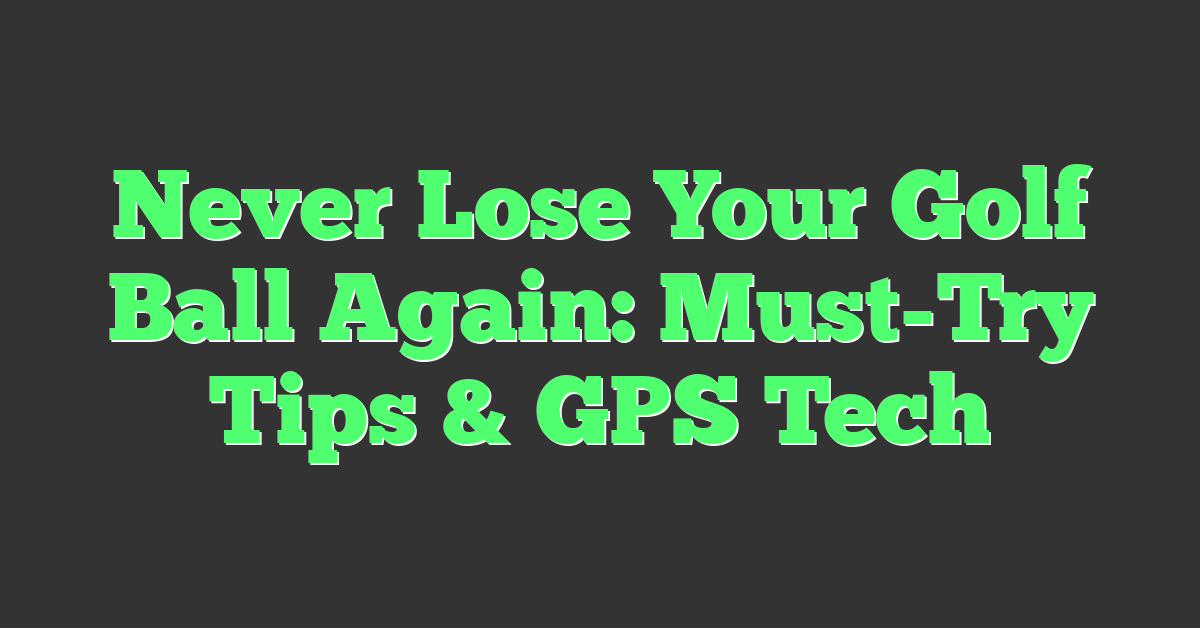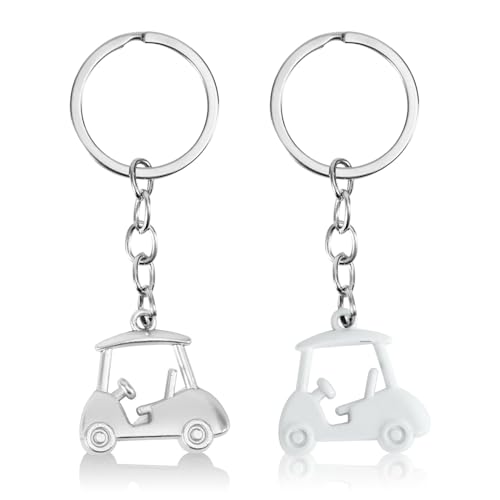Losing your golf ball can be a real drag, can’t it? You’ve smacked it down the fairway, but when you get there, it’s vanished. It’s not just frustrating; it’s like throwing money right into the rough!

The Importance of Not Losing Your Golf Ball
As a seasoned low handicap golfer, you know that keeping your ball in play is more than just a matter of pride; it’s a crucial aspect of scoring well. Losing a ball can throw off your game, mentally and financially. Plus, there’s the added penalty strokes that often make the difference between a good round and a frustrating one.
Each ball lost is a stroke added, and in the world of golf, strokes are precious. Here’s why not losing that little white sphere matters more than you might think:
Keeping Your Score Low
When you lose a ball, not only do you cope with the stroke penalty, but you’re also likely dropping another shot to get back into position. This can quickly escalate a potential par or bogey into a double or triple bogey, derailing your scorecard. Consistency is key in golf, and minimizing lost balls helps maintain that steady play.
Maintaining Momentum
Imagine this: you’re on a roll, hitting fairways and greens in regulation, then suddenly, you lose a ball, and it feels like all that momentum’s been sucked away. Fighting to get back into that rhythm can be a challenge. Keeping your ball in play helps you keep that flow, avoiding unnecessary disruptions to your rhythm.
Saving Money
Maybe it seems trivial to mention the cost of golf balls, but anyone who’s played the game knows that golf balls aren’t cheap, especially if you favor high-performance brands. Consider the expense of lost balls over multiple rounds, and you’ll see that it can add up significantly.
- Ball lost per round can often average $3 to $5
- A dozen quality golf balls can cost between $40 to $50
Playing carefully to avoid losing balls can cut down your expenses over time. That means more money saved for green fees, equipment upgrades, or even that dream golf trip you’ve been planning.
Building Confidence
Every time you keep your ball in play, you’re reinforcing your ability to control the course. This breeds confidence, which is a golfer’s best friend. Confident players are more likely to take calculated risks when they pay off and manage setbacks when they don’t.
Choose a High-Visibility Golf Ball
As a low-handicap golfer who’s played all your life, you know that every small advantage counts. With that in mind, consider how the color of your golf ball can influence your game. Choosing a high-visibility golf ball isn’t just a style preference; it’s a strategic move to keep your ball in sight.
Golf balls come in various hues, but the traditional white can sometimes blend with the sky or get lost among clouds. Instead, play with colors like vivid orange, yellow, or pink. These shades stand out against the green of the course and the blue of the sky, making them easier to track during flight and find on the ground.
High-visibility golf balls aren’t just for overcast days or twilight rounds. On sunny days, the glare can make it tough to keep an eye on a white ball. Colored balls, with their distinct contrast, reduce the chances of losing sight after a powerful drive. You’re less likely to lose your ball and face that stroke penalty when it’s brightly colored.
But it’s not just about the color. Many high-visibility balls are designed with additional features to help you maintain visual contact. For instance, some come with a UV-resistant matte finish that minimizes glare or with enhanced dimple patterns that improve aerodynamic consistency. These details help you stay locked on your ball from tee to green.
Remember, when shopping for these golf balls, you’re looking for a combination of vibrancy and performance. High-visibility doesn’t mean compromising on quality; many premium golf ball manufacturers offer models in these eye-catching shades. They have the same technology as the top white balls – spin control, distance, and feel – but with that added visibility edge.
Next time you’re at the pro shop or browsing online, give some thought to stocking your bag with a few high-visibility golf balls. You’ll appreciate the difference they can make, especially when it keeps your round going smoothly without the nuisance of a lost ball cutting into your focus and your wallet.
Keep Track of Your Golf Ball’s Flight
When you’re out on the fairways, tracking your golf ball’s flight is crucial. As someone who has played golf their whole life, I can tell you that having your eyes on the ball at all times is a game-changer — quite literally. But how exactly do you keep your ball in sight, especially after a powerful drive or a distant stroke?
First off, focus is key. You need to watch the ball as it leaves the clubface. Work on holding your finish and keeping your head down until after impact. This habit ensures a steady gaze during the crucial moments when the ball launches.
Develop a Spotting Technique
- Find a landmark: Before you swing, pick out a landmark in the direction you intend to hit.
- Use the landmark to refocus your eyes quickly after the shot.
- Stay balanced: A balanced swing leads to a controlled follow-through, letting you look up in a smooth motion.
Partner Up
Playing with a buddy? Make it a partnership:
- You track their ball, and they’ll track yours.
- Call out the ball’s direction: “left side fairway” or “heading towards the bunker.”
- Discuss with your partner the ball’s climb and descent for better locating.
Invest in Your Skills
Improving your own ball flight consistency makes tracking easier. With practice, you’ll recognize your patterns:
- High, low, draw, or fade – know your typical trajectory.
- Practice swing mechanics to fix erratic flights.
Remember, consistency is less about perfection and more about predictability. The more you play and improve your swing, the better you’ll get at predicting where your ball is headed. This doesn’t eliminate the need for high-visibility balls, but it certainly complements it by giving you better control and foresight.
Tracking the ball’s flight not only prevents loss but also informs on how to adjust your next move. Watch the pros — they have this skill down to an art, and while we’re not all pros, adopting their habits can massively enhance our own game. Embrace these strategies, and your confidence on the course will soar. After all, it’s a game of inches and every bit of knowledge counts.

Use Alignment Aids on Your Golf Ball
If you’re looking to keep your eye on the ball—literally—an often overlooked trick is to use alignment aids on your golf ball. Add a personal touch to your ball that can easily be spotted from a distance. By drawing lines or marks on your ball, you create unique identifiers that make your ball stand out among the sea of white dimples on the fairway or green.
Start with something as simple as a straight line with a permanent marker across the seam of the ball. This line can help you in two ways: First, it enables you to align your putts with greater accuracy, reinforcing confidence in your stroke; second, it serves as a visual cue when tracking your ball after a full swing.
A common technique is to use specific colors or patterns that resonate with your personal style. Whether it’s your favorite color or a design that speaks to you, this customization makes your golf ball uniquely yours. You’ll find this incredibly helpful when you hit into the rough or land on a busy green.
Beyond personal identification, take the time to practice with your marked balls. Aligning shots becomes second nature, and you’ll start to notice patterns in flight and landing spots. This habit is crucial as it subtly trains your brain to recognize your golf ball in play automatically.
Don’t underestimate the psychological advantage of marking your golf balls. . Seeing your personalized mark can give you a subliminal boost, knowing that every element of your game, down to the ball itself, is tailored for success. Remember, small details often make the most significant difference in games of precision like golf.

While you’re at it, why not include a motivational phrase or symbol? It might just be the nudge you need to keep your spirits high throughout all 18 holes. Just make sure your marks are within the rules of golf. Now, go ahead, give your ball some flair—your game will thank you for it.
Consider Using a GPS Golf Ball
You’ve been there before: hitting a perfect drive down the fairway only to have it disappear in the rough, or worse, end up out of bounds. As a seasoned golfer, you know that’s not just frustrating—it’s strokes added to your scorecard. That’s where a GPS golf ball comes into play.
These high-tech little wonders have a GPS chip embedded within them, enabling you to track their exact location via an app on your smartphone. Never lose a ball again, they say, and they’re not just whistling Dixie. Imagine the confidence of playing a bold shot over a hill or around a dogleg, knowing that regardless of where it ends, you’ll find it.
Using a GPS golf ball can have numerous advantages:
- Tracking in Real-Time: See the position of your ball immediately after it lands.
- Data on Your Gameplay: Get insights on your distance and trajectory, which can be a goldmine for improving your technique.
- Avoiding Penalties: Keep those penalty strokes off your card by finding every ball.
When it comes to brands, there are a few players in the market. Brands like OnCore offer high-performance GPS balls without compromising on quality or playability. They integrate seamlessly with your game, so there’s no awkward adjustment period—play as you always would, but with an added layer of technology on your side.

Though initially more expensive than a standard golf ball, think of the savings in the long run. No more buying new balls every round because you lost a dozen in the woods. Plus, the data you gather can be an invaluable tool to hone your skills.
Consider the trade-offs, though. The added tech means these balls have a slight weight difference, and some purists claim it affects the feel of the ball. However, for the average golfer looking to shave strokes off their game and save some money, it’s a compromise worth exploring.
Getting comfortable with a GPS golf ball may take a couple of rounds, but once you’re used to them, you’ll wonder how you ever got along without them. Give it a shot and watch your game transform.
Conclusion
So there you have it—you’re now armed with some savvy strategies to keep your golf ball from disappearing into the great unknown. Whether you’re jazzing up your ball with some personal flair or embracing the tech-savvy world of GPS golf balls, you’re on your way to a more efficient and frustration-free game. Remember, it’s not just about keeping an eye on that little white sphere; it’s about enhancing your performance and enjoyment on the course. So go ahead, give these tips a whirl and watch as your confidence soars with every swing. Who knows? With your newfound ball-tracking skills, your golf buddies might just start coming to you for advice!










